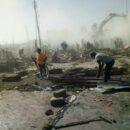New book reveals truth behind Angola’s forgotten massacre – By Richard Dowden

 When the journalist Lara Pawson asked me if RAS would host the launch of her book about an incident in Angola in 1977, I was in a dilemma. Loyalty to an old friend contended with the certainty that almost no one would want to waste an evening discussing an obscure massacre 37 years ago in Angola, a country we talk about infrequently.
When the journalist Lara Pawson asked me if RAS would host the launch of her book about an incident in Angola in 1977, I was in a dilemma. Loyalty to an old friend contended with the certainty that almost no one would want to waste an evening discussing an obscure massacre 37 years ago in Angola, a country we talk about infrequently.
How wrong was I? When we held the launch it was standing room only. We had a fascinating evening as Lara and other Angola-watchers peeled away decades of lies, buried by Angola’s rulers, plastered over by partisan journalists and sealed with Marxist jargon. The incident was finally opened up and discussed bluntly at SOAS.
The story is simple: on May 27 1977 several demonstrators in Luanda were shot in what was officially described by the ruling MPLA as a coup attempt. In the next few weeks thousands, possibly tens of thousands, of Angolans were arrested and executed. The incident has been wiped from the official Angolan memory.
Lara who spent two years in the 1990s as BBC correspondent in Luanda, tried to investigate it and found that not all Angolans had forgotten. Although most were too frightened to even mention it.
Before the end of apartheid in South Africa, Angola was the pivot on which the liberation of Southern Africa turned. Oil and diamond rich, heavily armed, with Cuban troops and Russian advisers on the ground, it was the main ally of the Soviet Union in southern Africa. It was also the training ground and launch-pad for Umkhonto we Sizwe, the armed wing of South Africa’s African National Congress and the guerrillas of SWAPO, the South West Africa People’s Organisation, fighting for Namibia. Angola was the war zone, the frontline against apartheid in the battle for South Africa.
In 1974 a military coup in Portugal had ended the country’s lengthy imperial adventure in Africa. Cape Verde, Guinea Bissau, Mozambique and Angola suddenly became independent. In Mozambique there was only one Liberation movement, Frelimo, but in Angola there were three; an American backed Popular Front for the Liberation of Angola, the FNLA, the Soviet Union backed Popular Movement for the Liberation of Angola, the MPLA and UNITA, backed by China and later by the US and apartheid South Africa.
Supported by Cuban troops and Russian arms, the MPLA had emerged as the winner but South Africa and America continued to support UNITA as a guerrilla force. Its spokesmen made much of the “foreign ideology” of the MPLA while the MPLA would complain that UNITA was racist.
This led to a bizarre but murderous conflict. Angola’s sources of wealth with which it paid for the war were diamonds and oil. Under Portuguese rule the diamonds were extracted and marketed by De Beers, the South African diamond company, although it created a shell company called Mining and Technical Services to obscure its real identity. The oil was extracted by American oil companies in Cabinda, the enclave north of the Congo river.
The Russians were unable or unwilling to replace them. So American oil workers and South African and British diamond miners were being protected by Cuban and Russian troops from attacks by South African and American-backed UNITA rebels who professed Socialism, Democracy and Negritude.
Now that is a word I have hardly heard since. But colour was – and probably still is – important in Angola. Portuguese mixed far more liberally with Africans than the British or French in Africa – or at least acknowledged their offspring. Unlike the British and French colonial masters who were directed by their governments in Europe, the Portuguese who came to Africa were venturers and entrepreneurs, mainly slave traders.
In other parts of Africa – except South Africa – mixed race people were so few that it didn’t matter. In Angola it did, especially when the Portuguese government encouraged white Portuguese emigration to the colonies and gave them land. The mixed race families who had been the traders were gradually pushed aside by the newly arrived white colonists in the 1950s. So they turned to the only political party in Portugal which would help them, the Portuguese Communist Party, and so learned the language of Marxism-Leninism and were given the wherewithal to fight back and reclaim their birthright.
I was always confused when I met MPLA officials because they made magnificent Soviet-style speeches about the glorious revolutionary struggles of the working class, the Povo, while sporting gold watches and smart London suits – looking more like the bourgeoisie that, in reality, they were. And I was shocked to find very few of them spoke an African language. That is why UNITA used the word “˜negritude’ as a slogan. “We are the real Africans here,” they seemed to be saying.
In 1977 there was a split along the same lines within the MPLA. Those outside the coastal mixed-race trading class which had inherited Angola resented the way in which these families that had once enslaved them, and had run the country for centuries, now ruled in the name of socialism. This appears to have been at the heart of the class – and possibly racial – split in the ruling MPLA party, the protest by Nito Alves and others and the subsequent murderous purge.
To this day few Angolans will talk about what happened. Was it a real coup attempt? Was there a split between the Cubans and Russians? No one outside the inner ruling circle in Angola, and Cuban and Russian officials knows. The Soviet archive on this topic is still locked.
As soon as the Soviet Union collapsed in 1989, the ruling party immediately privatized state lands and companies that they had run as officials and gave themselves ownership. So today Angola is still owned and run by an oligarchy of families that have exploited the country for hundreds of years.
The meeting at SOAS is the first time I have heard these events openly discussed. Previously leftist journalists in the UK would give the MPLA version and right wing journalists would give the UNITA version. Both suppressed or lied about what was really going on in Angola during these dreadful times. At this meeting neither of these groups came so it turned into a real discussion about what happened and why. I hope Lara’s book will spark a reinvestigation and reevaluation of this critical period in Africa’s history.
Richard Dowden is Director of the Royal African Society and author of Africa; altered states, ordinary miracles. Follow Richard on twitter@DowdenAfrica In the Name of the People – Angola’s Forgotten Massacre is published by I.B. Tauris







We in Africa need much more of this kind of books and interventions. The environment is full with lies and writers pretending that some are pure and perfect and others are killers and villains. It will help understand their past and work to avoid repeating the same mistakes. It shouLd be translated and circulated in Africa.